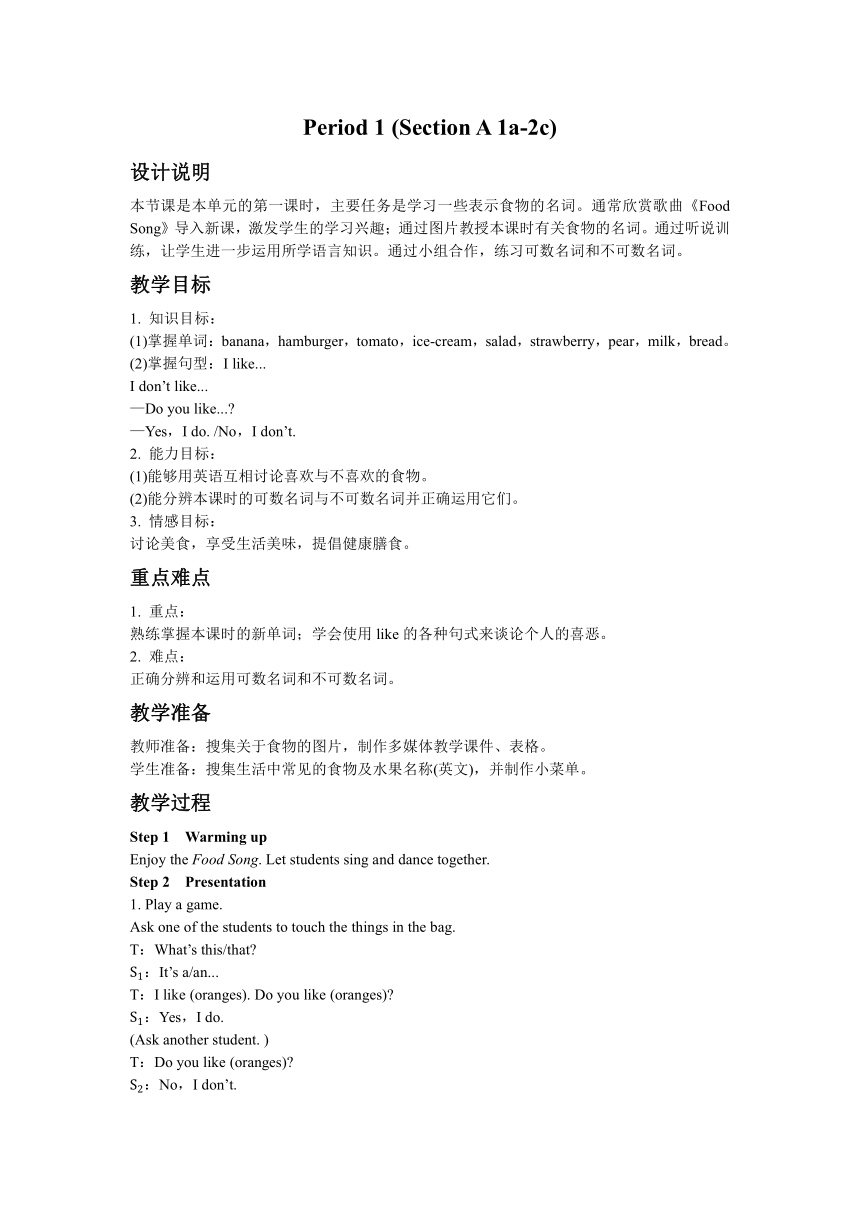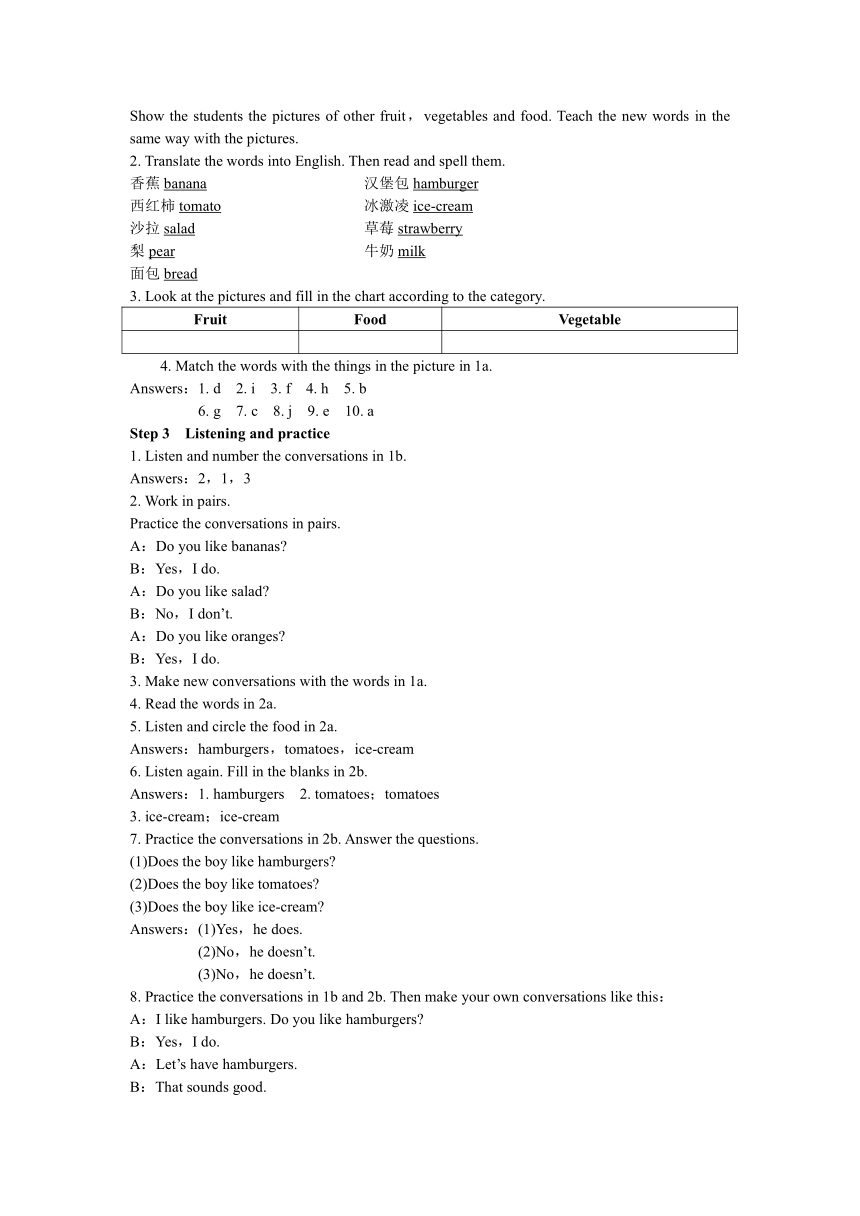人教版七年级英语上册 Unit 6 Do you like bananas? Section A(1a-2c)教案
文档属性
| 名称 | 人教版七年级英语上册 Unit 6 Do you like bananas? Section A(1a-2c)教案 |  | |
| 格式 | docx | ||
| 文件大小 | 27.3KB | ||
| 资源类型 | 教案 | ||
| 版本资源 | 人教新目标(Go for it)版 | ||
| 科目 | 英语 | ||
| 更新时间 | 2022-07-10 23:13:16 | ||
图片预览


文档简介
Period 1 (Section A 1a-2c)
设计说明
本节课是本单元的第一课时,主要任务是学习一些表示食物的名词。通常欣赏歌曲《Food Song》导入新课,激发学生的学习兴趣;通过图片教授本课时有关食物的名词。通过听说训练,让学生进一步运用所学语言知识。通过小组合作,练习可数名词和不可数名词。
教学目标
1. 知识目标:
(1)掌握单词:banana,hamburger,tomato,ice-cream,salad,strawberry,pear,milk,bread。
(2)掌握句型:I like...
I don’t like...
—Do you like...
—Yes,I do. /No,I don’t.
2. 能力目标:
(1)能够用英语互相讨论喜欢与不喜欢的食物。
(2)能分辨本课时的可数名词与不可数名词并正确运用它们。
3. 情感目标:
讨论美食,享受生活美味,提倡健康膳食。
重点难点
1. 重点:
熟练掌握本课时的新单词;学会使用like的各种句式来谈论个人的喜恶。
2. 难点:
正确分辨和运用可数名词和不可数名词。
教学准备
教师准备:搜集关于食物的图片,制作多媒体教学课件、表格。
学生准备:搜集生活中常见的食物及水果名称(英文),并制作小菜单。
教学过程
Step 1 Warming up
Enjoy the Food Song. Let students sing and dance together.
Step 2 Presentation
1. Play a game.
Ask one of the students to touch the things in the bag.
T:What’s this/that
:It’s a/an...
T:I like (oranges). Do you like (oranges)
:Yes,I do.
(Ask another student. )
T:Do you like (oranges)
:No,I don’t.
Show the students the pictures of other fruit,vegetables and food. Teach the new words in the same way with the pictures.
2. Translate the words into English. Then read and spell them.
香蕉banana 汉堡包hamburger
西红柿tomato 冰激凌ice-cream
沙拉salad 草莓strawberry
梨pear 牛奶milk
面包bread
3. Look at the pictures and fill in the chart according to the category.
Fruit Food Vegetable
4. Match the words with the things in the picture in 1a.
Answers:1. d 2. i 3. f 4. h 5. b
6. g 7. c 8. j 9. e 10. a
Step 3 Listening and practice
1. Listen and number the conversations in 1b.
Answers:2,1,3
2. Work in pairs.
Practice the conversations in pairs.
A:Do you like bananas
B:Yes,I do.
A:Do you like salad
B:No,I don’t.
A:Do you like oranges
B:Yes,I do.
3. Make new conversations with the words in 1a.
4. Read the words in 2a.
5. Listen and circle the food in 2a.
Answers:hamburgers,tomatoes,ice-cream
6. Listen again. Fill in the blanks in 2b.
Answers:1. hamburgers 2. tomatoes;tomatoes
3. ice-cream;ice-cream
7. Practice the conversations in 2b. Answer the questions.
(1)Does the boy like hamburgers
(2)Does the boy like tomatoes
(3)Does the boy like ice-cream
Answers:(1)Yes,he does.
(2)No,he doesn’t.
(3)No,he doesn’t.
8. Practice the conversations in 1b and 2b. Then make your own conversations like this:
A:I like hamburgers. Do you like hamburgers
B:Yes,I do.
A:Let’s have hamburgers.
B:That sounds good.
A:Let’s have ice-cream. Do you like ice-cream
B:Oh,no. I don’t like ice-cream.
Note:①Ask the students to pay attention to the forms of the nouns.
②The answers must be true for you.
Step 4 Group work
Present the countable nouns and the uncountable nouns.
T:Look!What are these (Show a picture. )
:They are oranges.
T:How many oranges are there
:Two.
T:What’s this (Show another picture. )
:It’s rice.
T:Can we count it Can we say a rice
:Sorry,I don’t know.
T:We can’t say a rice because it is an uncountable noun. Nouns include the countable nouns and the uncountable nouns. Countable nouns can be counted with number,and we usually add -s or -es to make the plural. For example,we can say an apple,two apples,three apples. Uncountable nouns can’t be counted with number,and they don’t have plurals. For example,we can say milk,rice,but we can’t say milks,rices.
T:Look at the pictures. Fill in the chart. (Show some pictures of fruits and vegetables. )
Countable nouns Uncountable nouns
Check the answers and work in groups.
1. 询问某人的喜好通常用一般疑问句:Do/Does+主语+like... 肯定答语为:Yes,主语+do/does. 否定答语为:No,主语+don’t/doesn’t. 其中do/does为助动词。
Do you like hamburgers 你喜欢汉堡包吗?
肯定答语:Yes,I do. 是的,我喜欢。
Does he like the pen 他喜欢这支钢笔吗?
否定答语:No,he doesn’t. 不,他不喜欢。
2. 名词分为可数名词和不可数名词。可数名词可以计数,分为单数和复数两种形式,指单个人或物时用单数形式,其前可用冠词a/an,基数词one等修饰;指两个或两个以上的人或物时用复数形式。不可数名词没有复数形式,其前不能用a/an,基数词或many等修饰,但可以用some,much等修饰。
3. 可数名词复数形式的变化规则:
(1)一般在词尾加-s。
book—books bag—bags
(2)以s,x,ch,sh结尾的词,一般在词尾加-es。
class—classes watch—watches
box—boxes brush—brushes
(3)以“辅音字母+y”结尾的词,先将y变为i,再加-es。
strawberry—strawberries family—families
(4)以o结尾的词,有的加-s,有的加-es。
photo—photos tomato—tomatoes
radio—radios
(5)以f或fe结尾的词,先将f或fe变为v再加-es。
knife—knives shelf—shelves
Step 5 Summary
In this lesson,we have learned:
1. the names of foods,fruits and vegetables.
2. the sentence structures about likes and dislikes.
3. how to tell the countable nouns and the uncountable nouns.
当堂达标(见导学案“当堂达标”)
答案与解析:
Ⅰ. 1. ice-cream ice-cream可作不可数名词,意为“冰激凌”。
2. tomatoes 由空格前的two可知,此处应用tomato的复数形式tomatoes。
3. pears pear为可数名词,此处应用其复数形式表示一类。
4. hamburgers hamburger为可数名词,其复数形式为hamburgers。
5. bread bread为不可数名词,a piece of bread意为“一片面包”。
Ⅱ. 1. rice 2. likes;doesn’t 3. strawberries 4. playing
5. have
Ⅲ. 1. B 问句的主语是your sister,为第三人称单数,故一般疑问句用助动词does,其否定回答为“No,she doesn’t. ”。
2. C 句意为“我喜欢西红柿,我的弟弟喜欢牛奶”。tomato的复数形式为tomatoes;milk为不可数名词,没有复数形式。
3. C Bob为第三人称单数,故第一个空用like的第三人称单数形式likes。Bill为第三人称单数,否定句要借助助动词does。
Ⅳ. 1. —Do you like bananas
—No,I don’t.
2. He doesn’t like apples.
3. Alice likes bread.
4. What do they like
Step 6 Homework
Make a survey and write a short passage to talk about you and your parents’ likes and dislikes. 板书设计
UNIT 6 Do you like bananas Period 1 (Section A 1a-2c)
Countable nouns Uncountable nouns banana(s) rice hamburger(s) milk pear(s) bread tomato(es) strawberry—strawberries I like... I don’t like... —Do you like salad —Yes,I do. /No,I don’t. —Does she like... —Yes,she does. /No,she doesn’t.
教学反思
设计说明
本节课是本单元的第一课时,主要任务是学习一些表示食物的名词。通常欣赏歌曲《Food Song》导入新课,激发学生的学习兴趣;通过图片教授本课时有关食物的名词。通过听说训练,让学生进一步运用所学语言知识。通过小组合作,练习可数名词和不可数名词。
教学目标
1. 知识目标:
(1)掌握单词:banana,hamburger,tomato,ice-cream,salad,strawberry,pear,milk,bread。
(2)掌握句型:I like...
I don’t like...
—Do you like...
—Yes,I do. /No,I don’t.
2. 能力目标:
(1)能够用英语互相讨论喜欢与不喜欢的食物。
(2)能分辨本课时的可数名词与不可数名词并正确运用它们。
3. 情感目标:
讨论美食,享受生活美味,提倡健康膳食。
重点难点
1. 重点:
熟练掌握本课时的新单词;学会使用like的各种句式来谈论个人的喜恶。
2. 难点:
正确分辨和运用可数名词和不可数名词。
教学准备
教师准备:搜集关于食物的图片,制作多媒体教学课件、表格。
学生准备:搜集生活中常见的食物及水果名称(英文),并制作小菜单。
教学过程
Step 1 Warming up
Enjoy the Food Song. Let students sing and dance together.
Step 2 Presentation
1. Play a game.
Ask one of the students to touch the things in the bag.
T:What’s this/that
:It’s a/an...
T:I like (oranges). Do you like (oranges)
:Yes,I do.
(Ask another student. )
T:Do you like (oranges)
:No,I don’t.
Show the students the pictures of other fruit,vegetables and food. Teach the new words in the same way with the pictures.
2. Translate the words into English. Then read and spell them.
香蕉banana 汉堡包hamburger
西红柿tomato 冰激凌ice-cream
沙拉salad 草莓strawberry
梨pear 牛奶milk
面包bread
3. Look at the pictures and fill in the chart according to the category.
Fruit Food Vegetable
4. Match the words with the things in the picture in 1a.
Answers:1. d 2. i 3. f 4. h 5. b
6. g 7. c 8. j 9. e 10. a
Step 3 Listening and practice
1. Listen and number the conversations in 1b.
Answers:2,1,3
2. Work in pairs.
Practice the conversations in pairs.
A:Do you like bananas
B:Yes,I do.
A:Do you like salad
B:No,I don’t.
A:Do you like oranges
B:Yes,I do.
3. Make new conversations with the words in 1a.
4. Read the words in 2a.
5. Listen and circle the food in 2a.
Answers:hamburgers,tomatoes,ice-cream
6. Listen again. Fill in the blanks in 2b.
Answers:1. hamburgers 2. tomatoes;tomatoes
3. ice-cream;ice-cream
7. Practice the conversations in 2b. Answer the questions.
(1)Does the boy like hamburgers
(2)Does the boy like tomatoes
(3)Does the boy like ice-cream
Answers:(1)Yes,he does.
(2)No,he doesn’t.
(3)No,he doesn’t.
8. Practice the conversations in 1b and 2b. Then make your own conversations like this:
A:I like hamburgers. Do you like hamburgers
B:Yes,I do.
A:Let’s have hamburgers.
B:That sounds good.
A:Let’s have ice-cream. Do you like ice-cream
B:Oh,no. I don’t like ice-cream.
Note:①Ask the students to pay attention to the forms of the nouns.
②The answers must be true for you.
Step 4 Group work
Present the countable nouns and the uncountable nouns.
T:Look!What are these (Show a picture. )
:They are oranges.
T:How many oranges are there
:Two.
T:What’s this (Show another picture. )
:It’s rice.
T:Can we count it Can we say a rice
:Sorry,I don’t know.
T:We can’t say a rice because it is an uncountable noun. Nouns include the countable nouns and the uncountable nouns. Countable nouns can be counted with number,and we usually add -s or -es to make the plural. For example,we can say an apple,two apples,three apples. Uncountable nouns can’t be counted with number,and they don’t have plurals. For example,we can say milk,rice,but we can’t say milks,rices.
T:Look at the pictures. Fill in the chart. (Show some pictures of fruits and vegetables. )
Countable nouns Uncountable nouns
Check the answers and work in groups.
1. 询问某人的喜好通常用一般疑问句:Do/Does+主语+like... 肯定答语为:Yes,主语+do/does. 否定答语为:No,主语+don’t/doesn’t. 其中do/does为助动词。
Do you like hamburgers 你喜欢汉堡包吗?
肯定答语:Yes,I do. 是的,我喜欢。
Does he like the pen 他喜欢这支钢笔吗?
否定答语:No,he doesn’t. 不,他不喜欢。
2. 名词分为可数名词和不可数名词。可数名词可以计数,分为单数和复数两种形式,指单个人或物时用单数形式,其前可用冠词a/an,基数词one等修饰;指两个或两个以上的人或物时用复数形式。不可数名词没有复数形式,其前不能用a/an,基数词或many等修饰,但可以用some,much等修饰。
3. 可数名词复数形式的变化规则:
(1)一般在词尾加-s。
book—books bag—bags
(2)以s,x,ch,sh结尾的词,一般在词尾加-es。
class—classes watch—watches
box—boxes brush—brushes
(3)以“辅音字母+y”结尾的词,先将y变为i,再加-es。
strawberry—strawberries family—families
(4)以o结尾的词,有的加-s,有的加-es。
photo—photos tomato—tomatoes
radio—radios
(5)以f或fe结尾的词,先将f或fe变为v再加-es。
knife—knives shelf—shelves
Step 5 Summary
In this lesson,we have learned:
1. the names of foods,fruits and vegetables.
2. the sentence structures about likes and dislikes.
3. how to tell the countable nouns and the uncountable nouns.
当堂达标(见导学案“当堂达标”)
答案与解析:
Ⅰ. 1. ice-cream ice-cream可作不可数名词,意为“冰激凌”。
2. tomatoes 由空格前的two可知,此处应用tomato的复数形式tomatoes。
3. pears pear为可数名词,此处应用其复数形式表示一类。
4. hamburgers hamburger为可数名词,其复数形式为hamburgers。
5. bread bread为不可数名词,a piece of bread意为“一片面包”。
Ⅱ. 1. rice 2. likes;doesn’t 3. strawberries 4. playing
5. have
Ⅲ. 1. B 问句的主语是your sister,为第三人称单数,故一般疑问句用助动词does,其否定回答为“No,she doesn’t. ”。
2. C 句意为“我喜欢西红柿,我的弟弟喜欢牛奶”。tomato的复数形式为tomatoes;milk为不可数名词,没有复数形式。
3. C Bob为第三人称单数,故第一个空用like的第三人称单数形式likes。Bill为第三人称单数,否定句要借助助动词does。
Ⅳ. 1. —Do you like bananas
—No,I don’t.
2. He doesn’t like apples.
3. Alice likes bread.
4. What do they like
Step 6 Homework
Make a survey and write a short passage to talk about you and your parents’ likes and dislikes. 板书设计
UNIT 6 Do you like bananas Period 1 (Section A 1a-2c)
Countable nouns Uncountable nouns banana(s) rice hamburger(s) milk pear(s) bread tomato(es) strawberry—strawberries I like... I don’t like... —Do you like salad —Yes,I do. /No,I don’t. —Does she like... —Yes,she does. /No,she doesn’t.
教学反思
同课章节目录
- starters 预备篇(2012秋审查)
- Unit 1 Good morning !
- Unit 2 What’s this in English?
- Unit 3 What color is it ?
- Unit 1 My name's Gina.
- Section A
- Section B
- Unit 2 This is my sister.
- Section A
- Section B
- Unit 3 Is this your pencil?
- Section A
- Section B
- Unit 4 Where's my schoolbag?
- Section A
- Section B
- Unit 5 Do you have a soccer ball?
- Section A
- Section B
- Unit 6 Do you like bananas?
- Section A
- Section B
- Unit 7 How much are these socks?
- Section A
- Section B
- Unit 8 When is your birthday?
- Section A
- Section B
- Unit 9 My favorite subject is science.
- Section A
- Section B
